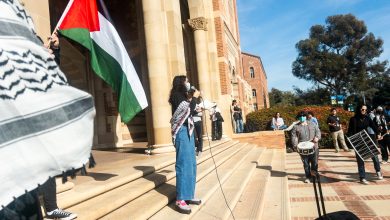Navigating the Workforce as an International Student

According to US News, international students make up almost twelve percent of UCLA’s undergraduate population and twenty percent of the graduate population. Yet, conversations with international students reveal that resources provided by the institution fail to ensure their academic or professional security. How does the process of finding employment opportunities work for international students? And why do so many international students report having a difficult time finding employment?
The majority of international students hold F1 visas, “the student visa” that allows them to study in the United States. Since the F1 visa is meant for non-immigrant students, international students are only allowed to work under certain conditions in accordance with complex guidelines and restrictions issued by the United States Citizenship and Immigration Service (USCIS). After completing their studies, those on an F1 visa are allowed to apply for Optional Practice Training (OPT), a period during which the USCIS permits F1 visa holders to work for one year on a student visa, either pre- or post-graduation. The long road of applications and visa complications is further exacerbated by the difficulties international students face in finding opportunities to work while they are still in school.
International students have to navigate additional barriers to secure employment in the United States. Arguably the easiest employment opportunity for students is working on campus, which requires no extra certifications or application. However, finding a job opening may be difficult as many on-campus jobs either require or prefer students with work-study. This is specifically a disadvantage for international students, who cannot qualify for work-study even though many have the financial need. While this doesn’t prevent international students from obtaining on-campus employment, it does considerably limit their options.
Off-campus employment only becomes an option for international students after completing their first academic year. At that point, a student wanting to work off-campus must be proactive in finding employment, receiving an offer, enrolling in the appropriate internship course, and having the position approved in order to receive the proper certification, Curricular Practice Training (CPT). All of that needs to be done before starting the job or internship. CPT permits F1 students to work off-campus for academic credit and is required whether the work is paid or unpaid.
On Feb. 25th, the UCLA Career Center hosted an event concerning employment options for F1 students. At this event, an advisor from the Dashew Center took the time to emphasize that the Trump administration is taking proper work certification for international students very seriously. She spoke of a student who had returned home over a break and was then confronted by customs about his work experience when trying to return to the United States. He was asked if he had worked in the United States, but the officer already knew the answer. He had documentation of this student’s resume which listed work he had done at a company while in the U.S. However, because he had no certification that allowed for this work, the customs officer denied him entry and his F1 status was revoked. This story shows a shocking reality. Even though his position was unpaid, and he argued it was volunteering, not an internship, it didn’t matter. This administration is taking extra measures to make life harder for international students.
During the event, advisors walked students through the steps required to get CPT. A student must first receive an employment/internship offer that is directly related to the student’s declared major, minor not included. Then, the student would have to go to the Dashew Center one to two weeks before they plan to start their internship to begin the application process for CPT. Lastly, the student must enroll in the internship or individual studies course (usually listed as a 195 or 199 course, but different for each major) during the academic term that coincides with when the employment will take. The class is also required for summer internships, meaning the student must enroll in the internship or individual studies course for at least one quarter over the summer. Both CPT authorization and enrollment in the internship or individual studies course are required for each quarter the student wishes to work off-campus.
While the Career Center’s event was informative in understanding the personal and professional obstacles that international students have to overcome, we wanted to understand the perspectives of international students in different fields in order to examine whether their experiences would reinforce or challenge the ideas presented at the event. To achieve this, we interviewed two international students, UCLA professor Anish Nag and UCLA Extension student Fatima Haadi. First, we spoke to Dr. Nag of the Department of Chemistry and Biochemistry. Dr. Nag finished his PhD in Chemistry at UCLA after graduating from the Indian Institute of Technology (IIT) back at his home in India. As a graduate student, he worked as a teaching assistant for several classes in the department and proceeded to become a professor upon graduation.
First and foremost, Dr. Nag informed us about the lack of resources that UCLA provides to international students to help them make a transition into professional or academic careers. Dr. Nag explained that “there are almost no resources. UCLA provides resources in terms of hiring fairs put on by various departments, but in order to have access to those opportunities, students must be very proactive themselves. They do not come to you with these opportunities.” Despite visits from various pharmaceutical and biotechnology companies, Dr. Nag still reported that the resources were limited.
When asked about his biggest fears for his professional career, Dr. Nag noted that it was not necessarily getting employment, but maintaining it. That fear stemmed partially from the same, winding immigration road international students must travel on that was referenced earlier. “The way immigration works here is that there are several different types of visas: I am currently on a F1 student visa, applying for OPT. For student visas, international applicants can only be hired as part-time.” In addition to the weight of not being able to get full-time employment, international students have the additional stress of having to apply for OPT after graduation. “OPT lasts one year, but is extendable to three for STEM majors.” After those three years, Dr. Nag would need to find employment based on an H1-B visa, for which a fixed amount is allocated based on a lottery system. “A lot of companies do not even consider international applicants because of the H1-B lottery system. It prevents complications down the line in the case that applicants are not granted a visa,” noted Dr. Nag. However, in the case that one does get the H1-B visa, “it lasts three years and is renewable to a total of six, at which stage applicants must apply for a green card. The current green card waiting time for Indian/Chinese nationals is 15 years.”
After learning about the difficult, prolonged process that international applicants face when applying for jobs, we were interested in learning what resources that Dr. Nag thought would have been helpful in retrospect. “The school should inform us of more international opportunities. Since opportunities are limited in the US, a lot of applicants search for employment options abroad. They have to do it by themselves,” he remarked. In the six years that Dr. Nag has been at UCLA, he saw only three instances where jobs were advertised abroad.
Current student Fatima Haadi, an international student from Morocco, shared some more startling insights into the bias encountered by international students. Haadi is currently completing a one-year finance certificate program at UCLA Extension. She completed her bachelor’s degree in Business Management and her master’s in Finance in Morocco and France.
Haadi’s experiences with finding internships, which she revealed after being asked about difficulties in securing employment, were most pressing. Haadi explained that “even finding jobs on campus was difficult. International students are not allowed to work off campus under the regulations of the F1 [student] visa.” Haadi began applying for on-campus jobs starting in May 2019, but only heard back and received employment in October 2019.
Upon hearing this, the question of why organizations need more time to decide whether to hire international students arose. Haadi addressed this in two simple words: green card. Many potential employers noted her strong qualifications could not outweigh her lack of a green card, although there are no legal restrictions on hiring non-green card holders, especially for unpaid internships. Haadi remarked that “I have been applying for internships since September. Over 180 internships. Only five got back to me. Two said no. I interviewed for three, but the question of a green card almost always made an appearance.”
Haadi proceeded to compare her experiences with that of an acquaintance, an international student from Brazil who received many more internship interviews than she did. The reason why was quite interesting: “they take out the location linked to their previous internships. For example, if he interned for a company in Brazil, he leaves all the information on his resume, but removes the location.” After removing the location, the acquaintance got a significant amount of interview requests.
After campus-wide research and conversations with both Dr. Nag and Fatima Haadi, it is clear that UCLA and educational institutions as a whole must do more to support the professional and academic advancement of international students. And students, both domestic and international, must press their institutions to reconsider outdated company policies that prioritize resident status over educational qualifications.




